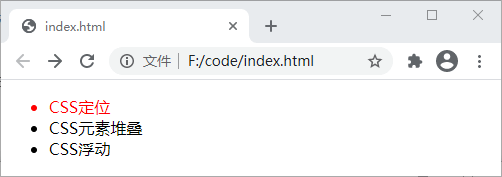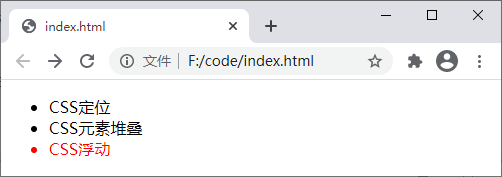CSS伪类选择器(非常详细)
伪类的名称不区分大小写,但需要以冒号
:开头。另外,伪类需要与 CSS 中的选择器结使用,语法格式如下:selector:pseudo-class {
property: value;
}
其中 selector 为选择器名称,pseudo-class 为伪类的名称。CSS 中提供了各种各样的伪类,如下表所示:
选择器 | 例子 | 例子描述 |
|---|---|---|
:active | a:active | 匹配被点击的链接 |
:checked | input:checked | 匹配处于选中状态的 <input> 元素 |
:disabled | input:disabled | 匹配每个被禁用的 <input> 元素 |
:empty | p:empty | 匹配任何没有子元素的 <p> 元素 |
:enabled | input:enabled | 匹配每个已启用的 <input> 元素 |
:first-child | p:first-child | 匹配父元素中的个子元素 <p>,<p> 必须是父元素中的个子元素 |
:first-of-type | p:first-of-type | 匹配父元素中的个 <p> 元素 |
:focus | input:focus | 匹配获得焦点的 <input> 元素 |
:hover | a:hover | 匹配鼠标悬停其上的元素 |
:in-range | input:in-range | 匹配具有指定取值范围的 <input> 元素 |
:invalid | input:invalid | 匹配所有具有无效值的 <input> 元素 |
:lang(language) | p:lang(it) | 匹配每个 lang 属性值以 "it" 开头的 <p> 元素 |
:last-child | p:last-child | 匹配父元素中的一个子元素 <p>, <p> 必须是父元素中的一个子元素 |
:last-of-type | p:last-of-type | 匹配父元素中的一个 <p> 元素 |
:link | a:link | 匹配所有未被访问的链接 |
:not(selector) | :not(p) | 匹配每个非 <p> 元素的元素 |
:nth-child(n) | p:nth-child(2) | 匹配父元素中的第二个子元素 <p> |
:nth-last-child(n) | p:nth-last-child(2) | 匹配父元素的倒数第二个子元素 <p> |
:nth-last-of-type(n) | p:nth-last-of-type(2) | 匹配父元素的倒数第二个子元素 <p> |
:nth-of-type(n) | p:nth-of-type(2) | 匹配父元素的第二个子元素 <p> |
:only-of-type | p:only-of-type | 匹配父元素中的 <p> 元素 |
:only-child | p:only-child | 匹配父元素中的子元素 <p> |
:optional | input:optional | 匹配不带 "required" 属性的 <input> 元素 |
:out-of-range | input:out-of-range | 匹配值在指定范围之外的 <input> 元素 |
:read-only | input:read-only | 匹配指定了 "readonly" 属性的 <input> 元素 |
:read-write | input:read-write | 匹配不带 "readonly" 属性的 <input> 元素 |
:required | input:required | 匹配指定了 "required" 属性的 <input> 元素 |
:root | root | 匹配元素的根元素,在 HTML 中,根元素永远是 HTML |
:target | #news:target | 匹配当前活动的 #news 元素(单击包含该锚名称的 URL) |
:valid | input:valid | 匹配所有具有有效值的 <input> 元素 |
:visited | a:visited | 匹配所有已经访问过的链接 |
前面在介绍《链接》时我们已经简单介绍了 :link、:visited、:active 和 :hover 几个伪类的使用,这里不再重复介绍,下面我们再来介绍几个比较常用的伪类。
1、first-child
伪类 first-child 能够匹配指定父元素下的个子元素,例如 ul li:first-child 能够匹配 <ul> 元素下的个 <li> 元素,示例代码如下:运行结果如下图所示:<!DOCTYPE html>
<html>
<head>
<style>
ul li:first-child { /*匹配<ul>下的个<li>标签*/
color: red;
}
</style>
</head>
<body>
<ul>
<li>CSS定位</li>
<li>CSS元素堆叠</li>
<li>CSS浮动</li>
</ul>
</body>
</html>

图:first-child 伪类
2、last-child
与 first-child 类似,伪类 last-child 能够匹配指定父元素下的一个子元素,例如 ul li:last-child 能够匹配 <ul> 元素下的一个 <li> 元素,示例代码如下:运行结果如下图所示:<!DOCTYPE html>
<html>
<head>
<style>
ul li:last-child { /*匹配<ul>下的一个<li>标签*/
color: red;
}
</style>
</head>
<body>
<ul>
<li>CSS定位</li>
<li>CSS元素堆叠</li>
<li>CSS浮动</li>
</ul>
</body>
</html>

图:last-child 伪类
3、nth-child
伪类 nth-child 是 CSS3 中新增的,它可以匹配指定元素下的第 n 个子元素,例如 ul li:nth-child(2) 能够匹配 <ul> 元素下的第二个 <li> 元素,示例代码如下:运行结果如下图所示:<!DOCTYPE html>
<html>
<head>
<style>
ul li:nth-child(2) { /*匹配<ul>下的第二个<li>标签*/
color: red;
}
</style>
</head>
<body>
<ul>
<li>CSS定位</li>
<li>CSS元素堆叠</li>
<li>CSS浮动</li>
</ul>
</body>
</html>

图:nth-child 伪类
- 随机文章
- 核心危机(核心危机魔石合成攻略)
- 风儿(风儿轻轻的吹)
- 饿了么红包怎么用(饿了么红包怎么用微信支付)
- 儿童教育文章(儿童教育)
- 光遇花手先祖位置(安卓光遇手花先祖)
- 广州4a广告公司(广州4a广告公司创意总监年薪)
- 抖音卡(抖音卡顿怎么解决)
- xboxones(xboxone手柄怎么配对主机)
- 陈武简历
- 海猫鸣泣之时游戏(海猫鸣泣之时游戏在哪玩)
- 儋州市第二中学(儋州市第二中学录取分数线)
- 鬼泣5攻略(鬼泣5攻略第三关怎么跳)
- 地球日主题(2020年世界地球日主题)
- 和柳亚子(和柳亚子先生于田)
- yy魔兽(yy魔兽世界)
- 国外成人游戏(国外成人游戏注册需要visa信用卡)
- 充值卡代理(充值卡代理加盟)
- 拆奶罩
- 郭妮小说(恶魔的法则郭妮小说)
- 东天目山(东天目山景区)
- 蝙蝠给人类的一封信(蝙蝠给人类的一封信)
- 大松电饭煲(美的大松电饭煲)
- 服饰加盟(服饰加盟店招商)
- 疯狂填字(疯狂填字5)
- 点对点短信息(点对点短信息费是什么意思)
- 观音普门品(观音普门品念诵全文)
- 河北省大运会(河北省大运会时间)
- 哈利波特官网(哈利波特官网在哪里)
- 骇客神条(骇客神条怎么辨别真假)
- 杜星霖(杜星霖图片)
